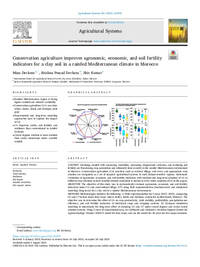Conservation agriculture improves agronomic, economic, and soil fertility indicators for a clay soil in a rainfed Mediterranean climate in Morocco

Authors:
CONTEXT: Declining rainfall with increasing variability, increasing temperature extremes, and declining soil fertility are threatening crop production and ultimately food security in the rainfed Mediterranean environment in Morocco. Conservation agriculture (CA) practices such as reduced tillage, soil cover, and appropriate crop rotation are recognized as a set of adaptive agricultural systems in such climate-sensitive regions. Systematic evaluation of agronomic, economic, and soil fertility indicators with medium-and long-term adoption of CA in different crop rotations in such variable climatic conditions is needed to drive wider adoption of CA in the region. OBJECTIVE: The objective of this study was to systematically evaluate agronomic, economic, and soil fertility indicators under CA and conventional tillage (CT) using field experimentation (medium-term) and simulation modeling (long-term) for a clay soil of a rainfed Mediterranean environment.
METHODS: Methodologies included the following: 1) Field experimentation for 5 years (2015–2019), comparing CA and CT in four major food crops: wheat, barley, lentil, and chickpea, conducted in Merchouch, Morocco. The objective was to determine the effect of CA on crop productivity, yield stability, profitability, precipitation use efficiency, and soil fertility indicators of individual crops and cropping systems. (2) Dynamic simulation modeling to understand the long-term effect of adopting CA and CT under cereal–legume and cereal–cereal rotation systems. Using 5 years of experimental data, we calibrated and validated a Decision Support System for Agrotechnology Transfer (DSSAT) model for four crops; and ran the model for 36 years for two major rotations.
